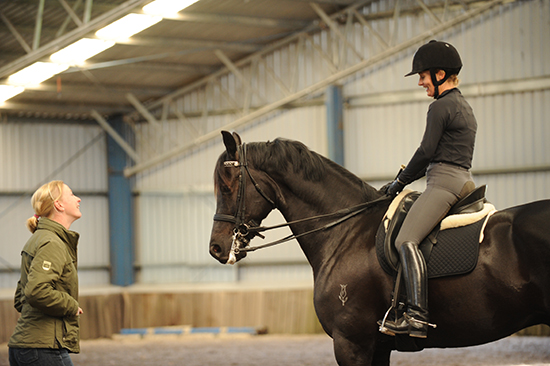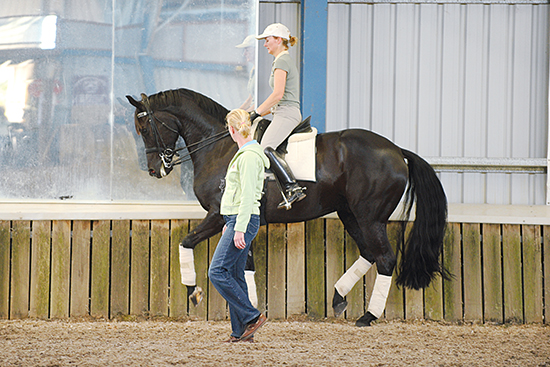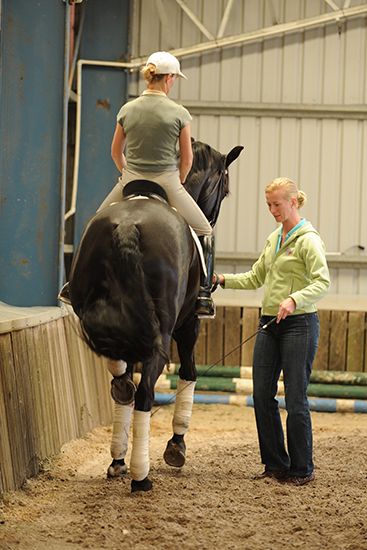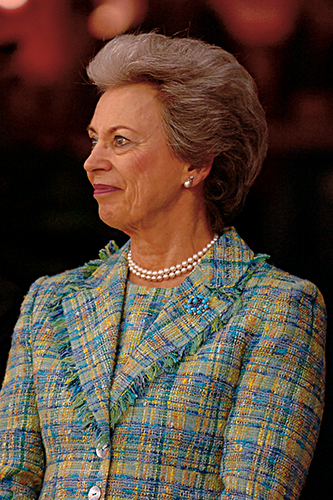 Story by Susan Mackenzie & Photos by Roz Neave, Peter Stoop, and Emma Flavelle
Story by Susan Mackenzie & Photos by Roz Neave, Peter Stoop, and Emma Flavelle
Olympic dressage team member, and now coach, Princess Nathalie of Denmark, hosted a series of dressage clinics in Australia, in Queensland and NSW with the last clinic being held in Victoria. who is Crown Prince Frederick’s cousin, won bronze in Hong Kong at the recent Beijing Olympic Games in the team dressage. She has trained extensively with Kyra Kyrklund and former German Team Coach Klaus Balkenhol.
An unassuming Princess Nathalie is first seen by us, casually eating a sandwich as we walk in. Dressed in jeans and a green horse jacket she looks like any other Australian dressage enthusiast, except for that very Scandinavian blonde hair…and the pictures pinned on the arena wall by a proud organizer (and Danish patriot) Pernille Hogg, of Princess Nathalie with her bronze medal.
The first horse we see is by Ferro, and is a big, black, flashy gelding, ridden by Monica Bird. The Flowervale Warmblood Stud bred the cute eight-year-old, Flowervale Ferro II, and Lauren Robson from the stud is in attendance proudly watching this very attractive horse work.
Monica gives the horse a quick warm up then Princess Nathalie walks onto the arena. After a brief chat and a pat on the nose for the little Ferro, they begin. Princess Nathalie immediately notices that the horse is not carrying himself correctly and needs to be straighter, with more impulsion and less speed. She really focuses on Monica’s position, asking her to sit her weight on her seat-bones and to focus on feeling her body keep with the rhythm of the horse, not working against it.
Straightness is very important to the Princess, and is focused on in later lessons as well. The horse is bulging on the circle and Monica has to really work to keep his outside shoulder on the circle and his hindquarters in line with the rest of his body.
Princess Nathalie tells Monica that “the left hand balances the left shoulder, the right hand balances the right shoulder”, and that the horse is not “allowed to balance himself on your hands, you’re only allowed to have the shoulders on your hands.” This is something Nathalie worked on when training with Kyra Kyrklund.
They begin with lots of little transitions to get the hindquarters working underneath the horse and the weight off her hands. “If he gets heavy on the outside rein, little half halt with inside rein, but keep him straight, and halt. He has to wait for you. Keep both shoulders in your hands, making a tunnel through your hands, and you want to keep his shoulders in that tunnel.”
The Princess is a very “teachy teacher”, giving detailed explanations of what is wanted, making sure Monica understands, using her body to demonstrate not only how the rider should be moving, but the horse as well. There is a sense of understanding from the Princess, that she knows what it means to train the horses and ride them each day. When talking about the position of the rider she tells Monica to relax her body and sit on his hind legs, as the horse is not allowed to move away from her weight, “it’s logical, but not easy. I know that. It’s taken me a while to realise that.” The concept of the rider balancing herself on the horse’s hindquarters is emphasised and Monica is repeatedly told to ‘stay sitting’ until the horse has “put his hind legs under your seat. Once he stays there you can ride him bigger.”
When the horse bulges through the corners the Princess tells Monica that she has to “feel his shoulders between her hands and knees,” that she is driving the horse through the tunnel and he cannot move outside that tunnel. “The horse needs to have his weight on his hindquarters so that you can move his shoulders anywhere you want to, if his weight is on his shoulders you cannot move them.”
The Princess emphasises the lower leg position, telling Monica not to take the leg so far back, but to keep it on the girth as the further back it goes, the more you tip forward, making you lose balance and lose your position on his hindquarters. “He is not allowed to swizzle off behind you and then go behind your leg.”
As the corrections are made the horse begins to move forward and sit on his hind legs, but then Nathalie focuses on the horse’s head position. He is coming slightly behind the bit, and the Princess tells Monica to “let him go slightly longer – he’s not allowed to hang down there – just so that he arches through your hand. You don’t want him to shorten and quicken, you want him slightly longer in the neck as it is easier for him to push off.” It is the same in canter, “don’t let him go short in the neck and hollow his back – longer – go back to trot without shortening the neck, he can’t lose that long neck.”
By the end of the lesson Monica has him working much better and riding ‘through the tunnel’ which the Princess described.
In the lesson the following day more lateral work is executed. With shoulder-in-left Princess Nathalie tells Monica to “ride the whole right side of the horse over to your left rein. Try to feel you can ride the whole right shoulder into your left rein.” This is emphasised again and the shoulder-in is improved.
In the half pass left the Princess tells Monica to “take the front leg onto the line, then, as he finishes, ask the hind leg to engage again, you need to feel that, feel that the right leg is stepping into the left rein as we don’t want the hindquarters leading.”
Again Nathalie focuses on position, “really try to get your weight on your seatbones. If you’re half leaning on your thighs, you’re stopping the horse’s movement. You need to feel how to swing with the movement. Leg not so far back. You can’t get the hind legs under if you can’t get the front legs to move away.”
In canter work Flowervale Ferro II is very forward and Princess Nathalie asks Monica if she feels out of control, which is affirmed with a convincing nod of the head. “You have to get comfortable with it, learn to ride him in that rhythm. You have to learn to have him in that bigger rhythm, really that’s the big round canter you want to have. You also have to think of the canter getting rounder and bigger, not faster.”
In the flying changes the horse is very forward and the Princess asks for more half-halts, “before changes use a half-halt, so you can get them big and he won’t run away.” The horse is immediately keeping rhythm better with more expression in the changes.
In walk the horse is not responding to Monica’s aids immediately, which is quickly seen by the Princess. They work at getting a response from every aid, “He has to think, ‘oh something is going to happen’ with every click, voice and leg. He needs to be ready.” This is worked on further in the piaffe as well, where the Princess uses the dressage whip to flick his legs and encourage the steps.
Chris Hector caught up with Monica Bird after the second day, and she was full of enthusiasm for the visitor’s teaching style:
“I think what makes Nathalie stand out from a lot of other instructors, is that not only does she concentrate on the horse, but she pays a lot of attention to the rider’s position. That’s what I’ve got most out of the clinic, her concentration on my position, throughout the whole lesson – not just in basic gaits, but my position in the lateral work. It really came home to me when she said – have the feeling that someone is pulling the trousers out from underneath you! That really got me to sit back. Not lean back but to get my bottom under. Another thing she said was ‘feel you can lift your knee towards the wither, on top of the saddle’. No one has ever said that to me, perhaps they have in other ways, but not like that, and it just kind of clicked.”
Your horse looks like one of those very athletic horses that can easily use their body to squirm out of your influence…
“He’s also a horse that takes a couple of days to settle in to a new environment. When I am at a competition I have to get there at least a day before the test to have him really settled in, so I can work on some relaxation. Princess Nathalie was very aware of that from day one, I guess that’s just her knowledge and experience. She was very strict on the outside rein, I guess horses with a longer neck can become slippery eels, but she was constantly reminding me about the outside rein, that’s excellent, that’s a teacher concentrating on the rider and the horse.”
Your horse looks pretty exciting when he starts to dance, he really wants to piaffe…
“I haven’t ridden at this level before and haven’t done any FEI work, it all feels new for me, and she was very patient with me which I thought was very nice. I felt the power from behind, and then channelled through to the front into the bridle, but coming through the wither – and that tied in with what she’d told me about my knee coming a little higher in the saddle. I really felt that in some of the half steps.”
She was working on getting your horse in a longer frame, he looks like he’d just like to suck back a little…
“The whole time, that’s his favourite thing, but again that’s working on relaxation. It’s the throughness, and me being a small person – Nathalie was able to tell me that driving him through, not down on the forehand because he’s the sort of horse that couldn’t go on the forehand, to just really channel through the knee, and feel like I am sitting on my tailbone, and forward and into the bridle. I just have to work on that feeling all the time, hopefully I’ll get it one day…”
RIDING AND BREEDING YOUR OWN
Chris Hector spoke with a free and easy, and very knowledgeable, Princess Nathalie on the first day of the Officer clinic:
You rode a home-bred horse at the Olympic Games in Hong Kong, what came first, riding or breeding?
“First riding, then my mother had a very nice mare, a present from the Danish Warmblood Association. We bred a filly by Donnerhall, and then we said, ah, that was such a nice horse, we’ll try it again. So we started breeding with her and that’s how we got going.”
Princess Benedikte – Patron of the World Breeding Federation for Sport Horses…
Yet for a long time people said it was too hard to breed dressage horses…
“I don’t believe that, we’ve shown that it is possible. Once Georg Theodorescu said ‘horses are not born Grand Prix stars, you make them’. So when you breed something, yes it has to have a little bit of talent and it has to have the head to be willing to do it – but even if it has a slight weakness you can help it get to Grand Prix. If you really want to do it, you can get them to Grand Prix.”
Do you have bloodlines that you particularly look for?
“We’ve used Donnerhall, we’ve used Rubinstein, I’ve used a little bit the Florestan blood, through a stallion Blue Hors had, Future Cup. Next year I hope I will have two foals by Diamond Hit. I like the Donnerhall blood very much, it suits me. They have the brain and they do have a talent for certain things. A lot of Donnerhalls have difficulties to go sideways and keep the rhythm, but they are deadly talented for piaffe / passage, and with the changes, you just have to find the right button and they are there. They just a take a little longer to develop…”
In what sense are they Danish Warmbloods, or are they European Warmbloods?
“The Danish Warmblood is put together from Holsteiner blood, Oldenburg, Hanoverian, and they have just made a cross and called it Danish Warmblood but it is based on German bloodlines. For me, a good horse has no brand and it has no colour.”
How many do you breed a year?
“I had no foals this year because I would have had to put up more stables and I didn’t want to do that. Next year we are going to have three foals. I try to only keep one or two foals, otherwise it gets too much.”
You said it started with the riding – were you the first of your family to ride?
“No, my mother still rides every day when she is at home. My father used to ride, but when he was young he had a really bad accident when the horse fell over and nearly killed him… he’s 73 now so he doesn’t ride. They rode mostly out in the forest. My mother now rides a lot of dressage, but that’s because of me.”
What got you into dressage?
“My mother took me to the European Championships in 1985, in Copenhagen, and I just said, Mummy I want to do this. There my heart fell for dressage.”
The credit for getting Princess Nathalie to travel to Australia goes to the Queensland dressage rider and trainer, Emma Flavelle a member of the Queensland State Dressage Squad.
Emma worked with the Princess for four months whilst in Germany and dreamed of bringing her to Australia:
“As I worked with Princess Nathalie in Germany it was always in the back of my mind once back in Australia, how will I continue on this path without her help? I knew I had to bring her out here for a refresher!” Emma organised the tour as well as the Queensland Clinic which was held at Grosvenor Park at Tinbeerwah. It was a big challenge but Emma was pleased at the end:
“I am so pleased I followed through with the idea to bring Nathalie to Australia as it has been such a great clinic. I haven’t organised a clinic before and was a bit worried as to how things would pan out. Now it is over I am very pleased with how things went and the riders were also thrilled. Nathalie loved our country and the people and has said she would love to return.”
Christine Crawford organised the two day clinic for Princess Nathalie in the Hunter Valley at her property ‘North Kaludah’. Christine said that ‘the lessons were some of the best ever’ and that the Princess was genuinely interested in every single horse and rider:
“The Princess used visualisation effectively, such as getting the riders to imagine they are riding through a tunnel, and your hands and knees are keeping them in that tunnel. She was a very friendly, nice person, who was passionate about teaching and riding. The riders were privileged to have these lessons. The riders had not known what to expect from a clinic with “a princess” but were very impressed with her knowledge, and the way she could coomunicate as well as her very pleasant and often humorous manner.”
“She was very accurate with her information, able to choose exactly the right time to deliver the message, getting results from all the horses.”
Pernille Hogg organised the Victorian clinic. Pernille, also from Denmark, had been very excited to help Emma Flavelle with the clinic and thought that it had been a big success:
“Everyone was really impressed and wanting more. She was so knowledgeable and gave riders what they were looking for. She wasn’t patching up errors, but going back to basics to get the horses to really improve. She focused on how the basics have to be there before you can do anything else. Stripping it right back to the foundations. It makes sense that you have to have them in front of your leg and have them sharp so that everything else works.”
Pernille is already working on the next clinic, which will be held early next year in New South Wales and Victoria: “Princess Nathalie really enjoyed doing the clinics, as well as seeing Australia. It has been great to work with her and we are sure we can put together a really good group of horses and riders for the next clinics.”
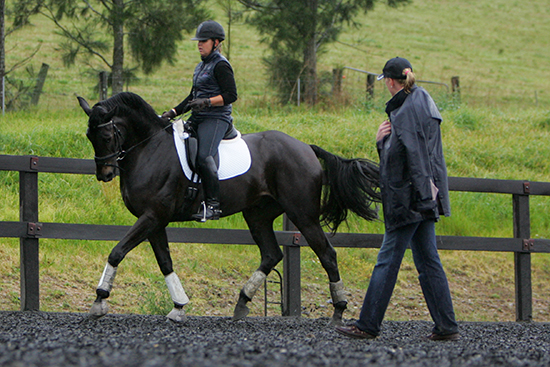 It’s chilly in the Hunter Valley…
It’s chilly in the Hunter Valley…
This article first appeared in THM November 2008.
There are lots more articles with Princess Nathalie – right here:



